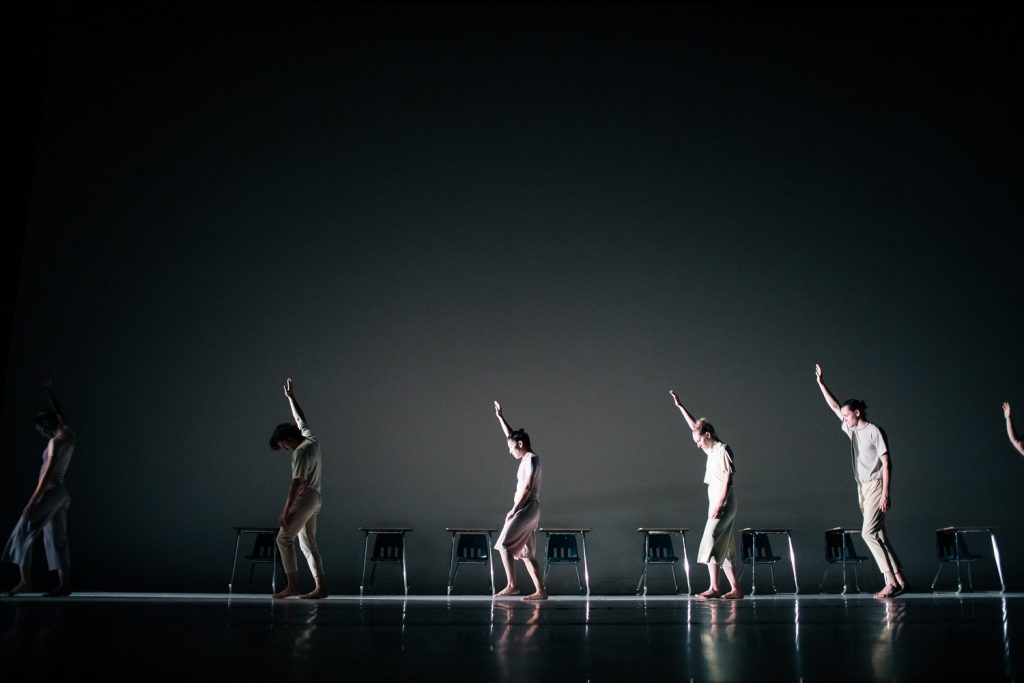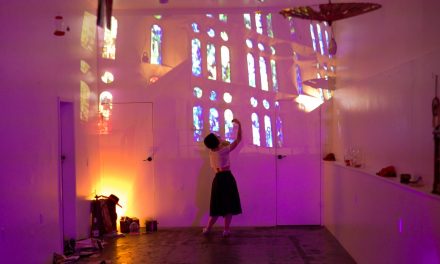Jacob Jonas The Company made its final performances this weekend as the 2018/2019 Company-in-Residence at the Wallis Annenberg Center for the Performing Arts. The work was exciting at times as the highly skilled dancers wowed us with the fusion of movement styles and acrobatic trademarks of Jacob Jonas. Jonas did venture into social issues like equal pay for equal work and the nation’s antiquated education system. It was very entertaining for many, but for me, it was clear that Jonas has yet to learn how to maintain continuity throughout his longer works. Instead, he often strayed from the central theme and resorted to amusing the audience with an overuse of physical tricks.
CRASH, choreographed by Jonas and performed to a dramatic original score composed and performed by Okaidja Afromso, had sections that were filled with images of waves ebbing and flowing, crashing ashore and then dispersing. Bodies rolled across the stage like incoming waves as beautifully lit arms became their white caps. We saw turbulence, created perhaps by a nearby storm, and a swimmer held aloft by moving human waves.
Perhaps the results would have been better had Jonas stayed true to the essence of CRASH and to these oceanic images. Had he not veered off into the trap of entertaining the audience, this would have been an extremely memorable endeavor. Sadly, I lost interest about three quarters of the way through and turned my focused to the magic being created in extremely dim light by Afromso.
CRASH was enhanced by the extraordinary talents of Lighting Designer William Adashek who, with a tinge of green, took us from the ocean’s edge, out to sea and back again. Born into a family of musicians and storytellers in the village of Kokrobite on the west coast of Ghana, Okaidja Afromso held my attention throughout with his amazing powerful singing and performance on guitar and percussion. The costumes that allowed us to see the movement yet flowed as needed to portray the images of water were designed by Tessa Matthias.
The agile cast of CRASH included Joy Isabella Brown, Lorrin Brubaker, Danielle Coleman, Emma Rosenzweig-Bock, Mike Tyus, Nicolas Walton, and Jill Wilson.
Jonas came back into focus with his short but strikingly to the point work TO THE DOLLAR. Here Jonas stayed true to his vision as he physically illustrated the importance of equal pay for women. Performed to a speech by Elizabeth Warren on Equal Pay Day in April of 2016, TO THE DOLLAR featured three duets in which the man and the woman executed identical and equally demanding movement. The phrases were performed in tightly-knit unison to prove that the female was not the weaker of the two sexes, but equally up to the task at hand and should be likewise compensated.
The cast included Joy Isabella Brown, Lorrin Brubaker, Emma Rosenzweig-Bock, Mike Tyrus, Nicolas Walton, and Jill Wilson. The very appropriate arena-like lighting was by Jacob Jonas.
viceversa was choreographed and performed by dancer/choreographer Daniel Ezralow and Jacob Jonas, and set to music by Australian experimental jazz trio, The Necks. Ezralow has enjoyed a wonderful career that includes performing with such notables as the Lar Lubovitch Dance Company and the Paul Taylor Dance Company. He has choreographed for numerous professional dance companies and was one of the original dancer/choreographers to create MOMIX, and a founding member of ISO Dance. Currently, he is the Artistic Director and Founder of Ezralow Dance.
I remember watching Ezralow perform with the Taylor company and I enjoyed seeing him perform again. viceversa was a moving portrait of the relationship between two strong male figures and it could have been a wonderful piece. What weakened the work was that it went on for too long and by the end the movement ideas felt forced and contrived. I do applaud Jonas for bringing Ezralow to the Wallis stage.
The starkly dramatic lighting for viceversa was by William Adashek.
The final work of the evening continued Jonas’ trend of not knowing when to edit out the sections that do not relate to the dance at hand. Lead by the very talented Georgia Bryan and driven by the original score and live performance by Nicole Miglis, member of the band Hundred Waters, THERE’S BEEN A STUDY was packed with visuals appropriate to the serious need for reform in our educational system, but the work lost its direction about two-thirds of the way through. Again, Jonas opted for the circus-like atmosphere instead of remaining true to his original vision.
Young Bryan stole the show as she narrated the history and failures of this nation’s method of learning. She spoke to how we treat all students as if they absorbed information at the same pace, had the same abilities, and that we force them into learning by rote rather than investigating each subject matter thoroughly and with interest. Bryan’s talents did not stop with her acting and oratorical skills. She also kept pace with the company dancers in a few of the movement sections. Finally, near the end, Bryan continued to inform us while executing her Cirque de Soleil type contortionist skills atop a small table created by placing together several school desks.
Jonas opened THERE’S BEEN A STUDY with a video of kindergarten age children speaking into a camera and explaining what they wanted to be when they grew up. It was adorable and amazing to hear that most of them wanted to be doctors, lawyers, teachers, firemen and as one child stated, inventors. The video demonstrated how all young children have dreams and talents and that they each want to grow up, nurture their talents and allowed to realize their dreams.
The projection screen doubled as a classroom whiteboard as the dancers were first seen seated in classroom desks with an arm raised, asking to be chosen so that she/he could recite the correct answer to the teacher’s question. Bryan’s narration explained the different stages and problems of our present educational system: lack of autonomy and control, inauthentic learning and testing, difference in how we learn, no room for passion or interests, and the freedom to have fun or to play like children. These were topics that I assume Jonas learned about during his research with the Director of Education of The Wallis, Mark Slavkin and perhaps his own experience in our “traditional” educational system.
For much of THERE’S BEEN A STUDY, Jonas approached these subjects with care and clarity, creating movement that spoke to them directly. Example: to illustrate learning by rote, Jonas had the dancers perform a very rhythmic movement sequence in unison, even while moving the desks to different areas of the stage.
Then he deserted his original purpose by creating a very long section to solely highlight the dancers’ acrobatic abilities and agility before he eventually returned to the plight of our students with one last narration and the fluttering of scrantron test answer sheets from the catwalk above the audience.
The dancers are very good at what they do and Jonas’ ability to create intricate athletic partnering is admirable. He should be encouraged to continue investigating all these elements, but like the majority of choreographers, he needs an outside eye that he trusts to give him an honest and unbiased critique beyond that of his adoring fan base. The cast of THERE’S BEEN A STUDY was Joy Isabella Brown, Lorrin Brubaker, Georgia Bryan, Danielle Coleman, Emma Rosenzweig-Bock, Madison Olandt, Brin Schoellkopf, Mike Tyus, and Jill Wilson.
For more information on Jacob Jonas The Company, click here.
To take a look at The Wallis’ performance calendar, click here.
Featured image: To The Dollar by Jacob Jonas, (L to R) Joy Isabelle Brown, Nicolas Walton – Photo by Matthew Brush














